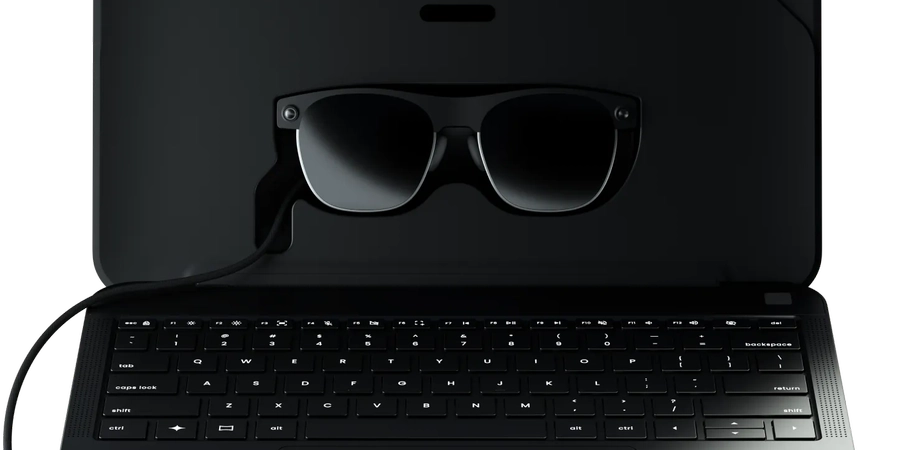# TL;DR
The Spacetop G1 is a groundbreaking AR laptop designed to revolutionize productivity for entrepreneurs on the go. Developed by Sightful, this $1,900 device creates a virtual workspace through AR glasses, offering unparalleled portability, privacy, and efficiency. Key features include a Qualcomm Snapdragon chipset, 16 GB RAM, 128 GB storage, and an 8-hour battery life. Despite its innovative design, the tethered AR glasses limit mobility and add weight, while its custom SpaceOS may lack compatibility with certain applications. Comparatively, the Apple Vision Pro offers higher resolution and better ecosystem integration but at a higher price. Overall, the Spacetop G1 is a compelling choice for forward-thinking entrepreneurs.
# Introduction
The Spacetop G1 stands as a revolutionary innovation, poised to transform productivity for entrepreneurs on the move. This screenless AR laptop, developed by Israeli tech firm Sightful, leverages augmented reality (AR) to create a virtual workspace that surpasses the limitations of traditional laptops. Priced at $1,900, the Spacetop G1 is poised to challenge the status quo, offering a unique blend of portability, privacy, and productivity. This article delves into the specifics of the Spacetop G1, its benefits and drawbacks, and how it compares to the Apple Vision Pro, providing a comprehensive overview for entrepreneurs seeking cutting-edge technology to enhance their work efficiency.
# The Spacetop G1: A Detailed Overview
# Specifications and Features
The Spacetop G1 is a marvel of modern engineering, combining sleek hardware with advanced AR technology. Here are the key specifications and features that set it apart:
-
Size & Weight: The Spacetop G1 fits comfortably in a standard laptop bag, with dimensions of 11.81 inches (30.0 cm) in width, 9.09 inches (23.1 cm) in depth, and a height ranging from 0.51 inches (1.3 cm) to 2.44 inches (6.2 cm). It weighs 3.08 lbs (1.4 kg), with the AR glasses adding a mere 0.18 lbs (85 grams).
-
Chipset: Powered by the Qualcomm Snapdragon QCS8550 platform, the Spacetop G1 features a KRYO CPU and Adreno 740 GPU, supported by dual eNPU V3 AI processors capable of 48 INT8 and 12 FP16 TOPs.
-
Memory & Storage: The device boasts 16 GB of LPDDR5 RAM and 128 GB of UFS 3.1 storage, with 102 GB available for use.
-
Battery & Charging: Equipped with a 60W battery, the Spacetop G1 offers up to 8 hours of usage on a single charge. It supports fast charging, reaching 85% in less than 2 hours, with a dual-port USB-C power adapter providing up to 63W.
-
AR Glasses: The AR glasses feature dual OLED display panels with a resolution of 1920x1080 pixels per eye, a 90Hz refresh rate, a 50° field of view, and 42 pixels per degree (PPD). They support custom prescription lenses ranging from -8.00D to +6.00D.
-
Audio & Connectivity: The glasses include 2X open-ear speakers, while the base unit has 6W stereo speakers and a microphone optimized for online meetings. Connectivity options include Wi-Fi 7, Bluetooth 5.3, 5G/LTE NR Sub-6, eSIM, and a Nano-SIM card slot.
-
Operating System: The Spacetop G1 runs on SpaceOS, a custom operating system optimized for spatial computing, built on top of Google’s ChromiumOS.
# Design and Portability
The Spacetop G1 is designed with portability in mind. Its slim profile and lightweight hardware make it easy to carry, fitting seamlessly into a standard laptop sleeve. The AR glasses are stylish, comfortable, and feature automatic dimming in bright environments, ensuring lossless text legibility and enhanced focus. The device’s magnesium body and hard cover provide robust protection for the glasses when stored, making it a practical choice for entrepreneurs who are constantly on the move.
# Performance and Productivity
The Spacetop G1 is engineered to boost productivity with its expansive 100-inch virtual workspace. This virtual canvas allows users to multitask efficiently, positioning multiple windows around them in 3D space. The device’s 70% faster Qualcomm chipset, combined with 48 TOPS of AI compute, ensures smooth performance and quick response times, making it ideal for handling various business tasks simultaneously.
# Benefits for Entrepreneurs
# Enhanced Productivity
The Spacetop G1’s primary advantage lies in its ability to create a nearly infinite workspace. Entrepreneurs can manage emails, browse the web, and work on presentations all at once, without the constraints of a physical screen. This flexibility is particularly beneficial for those who need to juggle multiple tasks and applications throughout the day.
# Portability and Convenience
The lightweight and compact design of the Spacetop G1 makes it an excellent choice for entrepreneurs who travel frequently. The AR glasses provide a large virtual display without the bulk of a traditional monitor, allowing users to work comfortably in confined spaces such as airplanes or coffee shops.
# Privacy and Security
The AR glasses offer a unique level of privacy, as the virtual screen is only visible to the wearer. This feature is invaluable for entrepreneurs who handle sensitive information and need to ensure that their work remains confidential, even in public settings.
# Advanced Connectivity
With support for Wi-Fi 7, Bluetooth 5.3, and 5G/LTE, the Spacetop G1 ensures that entrepreneurs stay connected wherever they go. The dual SIM support, including eSIM and Nano-SIM, provides additional flexibility for international travel and remote work.
# Drawbacks and Considerations
# Limited Battery Life
While the Spacetop G1 offers up to 8 hours of battery life, this may not be sufficient for extended work sessions, especially during long-haul flights or full-day conferences. Entrepreneurs may need to carry a portable charger or plan for charging breaks throughout the day.
# Tethered AR Glasses
The Spacetop G1’s glasses being tethered to the laptop base present several drawbacks that could impact user experience and practicality:
-
Limited Mobility and Convenience: The tethering of the AR glasses to the laptop base restricts the user’s mobility. Unlike standalone AR or VR headsets, which allow for more freedom of movement, the Spacetop G1 requires users to remain relatively close to the laptop base. This can be inconvenient, especially in situations where users need to move around frequently or work in different positions.
-
Increased Weight and Discomfort: The tethering cable adds extra weight and can cause discomfort over extended periods. Users have reported that the glasses, which weigh 85 grams, feel heavier due to the USB cable required for tethering. This can lead to strain and discomfort, particularly during long work sessions.
-
Potential for Damage: The physical connection between the glasses and the laptop base increases the risk of damage. The cable can be a point of failure if it gets snagged or pulled accidentally. Additionally, the glasses are hardwired to the laptop, making them more vulnerable to damage during transport or storage. Users have expressed concerns about the durability and safety of the glasses when carrying the device in a bag.
-
Cumbersome Setup: The need to manage the tethering cable can make the setup process more cumbersome. Users must ensure that the cable is properly connected and positioned, which can be a hassle, especially in tight or crowded spaces like airplanes or cafes. This detracts from the seamless and portable experience that the Spacetop G1 aims to provide.
-
Reduced Aesthetic Appeal: The presence of a tethering cable can detract from the sleek and modern aesthetic of the Spacetop G1. While the device is designed to be stylish and innovative, the visible cable can make it look less polished and more cumbersome compared to fully wireless AR solutions.
-
Interference with Other Activities: The tethering cable can interfere with other activities or objects in the user’s environment. For instance, the cable might get in the way when reaching for items on a desk or moving around in a confined space. This can be particularly problematic in dynamic work environments where users need to interact with various tools and devices.
-
Limited Field of View: While not directly related to the tethering, the limited field of view of the AR glasses (50 degrees) means users have to move their heads more to see different parts of the virtual workspace. The tethering cable can exacerbate this issue by restricting head movement and making it more cumbersome to navigate the virtual environment.
# Custom Operating System
The Spacetop G1 runs on SpaceOS, a custom operating system built on ChromiumOS. While it supports most web apps, compatibility with native desktop applications is limited. This could be a drawback for entrepreneurs who rely on specific software that is not web-based.
# Price Point
At $1,900, the Spacetop G1 is a significant investment. While it offers unique features and benefits, entrepreneurs must weigh the cost against their specific needs and consider whether the device’s advantages justify the price.
# Comparison with Apple Vision Pro
The Apple Vision Pro is another prominent player in the AR and spatial computing market. Here’s how the Spacetop G1 stacks up against it:
# Design and Comfort
The Apple Vision Pro is known for its high-quality build and immersive experience, but it is also heavier and bulkier compared to the Spacetop G1. The Vision Pro integrates all its technology into the headset, making it less comfortable for extended use. In contrast, the Spacetop G1 separates the computing power from the glasses, resulting in a lighter and more comfortable experience.
# Display Quality
The Vision Pro boasts a higher resolution with over 11 million pixels per eye, providing a more detailed and immersive visual experience. The Spacetop G1, with its 1920x1080 resolution per eye, offers a lower resolution but still delivers clear and crisp visuals suitable for productivity tasks.
# Operating System and Ecosystem
The Vision Pro runs on visionOS, which is designed to integrate seamlessly with Apple’s ecosystem, offering a wide range of applications and services. The Spacetop G1’s SpaceOS, while innovative, is more limited in terms of app compatibility
and ecosystem integration. Entrepreneurs who are heavily invested in Apple’s ecosystem may find the Vision Pro more appealing.
# Price and Value
The Vision Pro is priced higher than the Spacetop G1, reflecting its advanced features and higher resolution. However, the Spacetop G1 offers a compelling value proposition for entrepreneurs focused on productivity and portability, without the need for the high-end entertainment and gaming features of the Vision Pro.
# Real User Reviews
# Positive Feedback
Users who have tested the Spacetop G1 during its early access phase have praised its innovative design and productivity-enhancing features. Many appreciate the large virtual workspace and the privacy offered by the AR glasses. The lightweight and comfortable design of the glasses has also received positive feedback, making it suitable for long-term use.
# Areas for Improvement
Some users have noted the limited field of view and the need for frequent head movements to navigate the virtual workspace. The custom operating system, SpaceOS, has also been a point of contention, with some users finding it less intuitive and lacking compatibility with certain applications. Battery life has been another area of concern, with users hoping for longer usage times in future iterations.
# Conclusion
The Spacetop G1 represents a significant leap forward in the realm of mobile computing, offering entrepreneurs a unique blend of portability, privacy, and productivity. Its innovative use of AR technology to create a virtual workspace sets it apart from traditional laptops and positions it as a valuable tool for the modern entrepreneur. While it has its drawbacks, such as limited battery life and a custom operating system, the benefits it offers make it a compelling choice for those seeking to enhance their work efficiency on the go.
As the market for spatial computing continues to evolve, the Spacetop G1 stands out as a pioneering device that challenges the conventional notions of what a laptop can be. For entrepreneurs looking to stay ahead of the curve and embrace the future of mobile workspaces, the Spacetop G1 is a worthy investment that promises to revolutionize the way we work.
# Frequently Asked Questions
# What is the Spacetop G1?
The Spacetop G1 is a screenless AR laptop developed by Israeli tech firm Sightful. It leverages augmented reality (AR) to create a virtual workspace, offering a unique blend of portability, privacy, and productivity.
# How much does the Spacetop G1 cost?
The Spacetop G1 is priced at $1,900.
# What are the key specifications of the Spacetop G1?
- Size & Weight: 11.81 inches (width), 9.09 inches (depth), height ranges from 0.51 inches to 2.44 inches, and it weighs 3.08 lbs. The AR glasses weigh 0.18 lbs.
- Chipset: Qualcomm Snapdragon QCS8550 with KRYO CPU and Adreno 740 GPU.
- Memory & Storage: 16 GB of LPDDR5 RAM and 128 GB of UFS 3.1 storage.
- Battery: 60W battery offering up to 8 hours of usage.
- AR Glasses: Dual OLED display panels, 1920x1080 pixels per eye, 90Hz refresh rate, and 50° field of view.
- Connectivity: Wi-Fi 7, Bluetooth 5.3, 5G/LTE NR Sub-6, eSIM, and a Nano-SIM card slot.
# What operating system does the Spacetop G1 use?
The Spacetop G1 runs on SpaceOS, a custom operating system optimized for spatial computing, built on top of Google’s ChromiumOS.
# What are the main benefits of using the Spacetop G1?
- Enhanced Productivity: Create a nearly infinite workspace for multitasking.
- Portability and Convenience: Lightweight design suitable for frequent travelers.
- Privacy and Security: Virtual screen visible only to the wearer.
- Advanced Connectivity: Supports Wi-Fi 7, Bluetooth 5.3, and 5G/LTE.
# What are the drawbacks of the Spacetop G1?
- Limited Battery Life: Up to 8 hours of usage may not suffice for extended work sessions.
- Tethered AR Glasses: Restricts user mobility, adds weight, potential for damage, and cumbersome setup.
- Custom Operating System: Limited compatibility with native desktop applications.
- Price Point: Considerable investment at $1,900.
# How does the tethering of AR glasses affect user experience?
The tethering of the AR glasses to the laptop base restricts mobility, adds weight and discomfort, increases the risk of damage, and makes setup cumbersome. It also detracts from the aesthetic appeal and can interfere with other activities.
# How does the Spacetop G1 compare to the Apple Vision Pro?
- Design and Comfort: Spacetop G1 is lighter and more comfortable due to its separate computing base.
- Display Quality: Vision Pro offers higher resolution with over 11 million pixels per eye.
- Operating System: Vision Pro runs on visionOS with better ecosystem integration.
- Price: Vision Pro is priced higher, offering advanced features and higher resolution.
# What do users say about the Spacetop G1?
Positive feedback includes its innovative design, productivity-enhancing features, and comfortable AR glasses. Areas for improvement noted by users include the limited field of view, cumbersome head movements, custom operating system, and battery life.
# Is the Spacetop G1 a good investment for entrepreneurs?
The Spacetop G1 offers a unique blend of portability, privacy, and productivity, making it a compelling choice for entrepreneurs seeking to enhance work efficiency on the go. Despite some drawbacks, its benefits make it a worthy investment for those looking to stay ahead of the curve in mobile workspaces.
# Further Reading Resources
For those interested in diving deeper into the Spacetop G1 and the broader context of augmented reality (AR) and spatial computing, the following resources provide a wealth of information. These articles, reviews, and technical papers cover various aspects of the Spacetop G1, its technology, and its place within the evolving landscape of AR and spatial computing.
# Spacetop G1 Specific Resources
-
Introducing Spacetop G1: The Laptop For The Spatial Computing Era This article provides an in-depth introduction to the Spacetop G1, highlighting its specifications, features, and the vision behind its creation. It also discusses the device’s potential impact on mobile working and productivity. Read more [1]
-
Spacetop G1 Hands-On Review: The World’s First Screen-Free AR Laptop A hands-on review that offers personal insights and experiences with the Spacetop G1. It covers the device’s design, usability, and performance, providing a practical perspective on its benefits and drawbacks. Read more [2]
-
Sightful Spacetop G1: Specs, Features, Release Date, Price This article from WIRED details the technical specifications, design improvements, and new features of the Spacetop G1. It also includes first impressions and a brief overview of the device’s market positioning. Read more [5]
-
Spacetop G1 Is a Screenless Laptop Using AR Glasses An overview of the Spacetop G1’s unique approach to mobile computing, focusing on its AR glasses and virtual workspace. The article discusses the device’s potential to revolutionize productivity and its competitive positioning against other AR devices. Read more [15]
-
Spacetop G1 AR Laptop With 100-Inch Virtual Screen Now Available for Preorder This article provides information on the pre-order availability of the Spacetop G1, along with details on its features, user feedback from the early access phase, and improvements made based on that feedback. Read more [18]
# Augmented Reality and Spatial Computing
-
Unveiling the Era of Spatial Computing A comprehensive paper that explores the concepts and applications of spatial computing, including AR, VR, and mediated reality. It provides a detailed overview of the technologies underpinning spatial computing and their potential future developments. Read more [3]
-
An Edge-Computing Based Architecture for Mobile Augmented Reality This technical paper discusses the challenges and solutions for mobile AR applications, focusing on reducing processing delay and energy consumption through edge computing. It provides valuable insights into the technical aspects of AR development. Read more [6]
-
Forging the Industrial Metaverse: Where Industry 5.0, Augmented and Mixed Reality, IIoT, Opportunistic Edge Computing, and Digital Twins Meet This article delves into the concept of the Industrial Metaverse, exploring how AR and other XR technologies can be integrated into industrial applications. It provides a forward-looking perspective on the role of spatial computing in Industry 5.0. Read more [10]
-
VR, AR, and Mixed Reality Resources A curated list of resources for those interested in VR, AR, and mixed reality. It includes tools, courses, and articles that can help developers and enthusiasts get started with these technologies. Read more [13]
-
zSpace - Virtual and Augmented Reality Research Guide This guide provides information on zSpace AR/VR devices and their applications in educational settings. It includes technical specifications and usage guidelines for zSpace Inspire laptops, which offer a different approach to AR computing. Read more [14]
# Industry Insights and Comparisons
-
Sightful Introduces Spacetop G1 as a Laptop for the Spatial Computing Era An article from VentureBeat that introduces the Spacetop G1 and discusses its potential to transform mobile computing. It includes insights from industry experts and comparisons with other AR devices. Read more [11]
-
AR Laptop Spacetop G1 With 100-Inch Virtual Screen Now Available for Preorder This article from Neowin provides an overview of the Spacetop G1’s features and pre-order details. It highlights the device’s unique selling points and improvements made based on early user feedback. Read more [8]
-
AR Laptop Spacetop Available for Pre-Order – But Is This the Future? An article from 9to5Mac that explores the potential of the Spacetop G1 and its implications for the future of AR/VR devices. It includes personal experiences and opinions on the device’s usability and market potential. Read more [19]
-
Meet the World’s First Augmented Reality Laptop – the Spacetop G1 This article from Yanko Design provides an overview of the Spacetop G1’s design, features, and potential impact on the market. It compares the device to other AR and VR headsets, highlighting its unique approach to mobile computing. Read more [17]
-
Introducing Spacetop G1: The Laptop For The Spatial Computing Era An article from Silicon that introduces the Spacetop G1 and discusses its potential to revolutionize productivity. It includes insights from industry leaders and details on the device’s technical specifications and features. Read more [12]
These resources provide a comprehensive understanding of the Spacetop G1, its technology, and its place within the broader context of AR and spatial computing. Whether you’re an entrepreneur looking to enhance your productivity or a tech enthusiast interested in the latest innovations, these articles and papers offer valuable insights and information.






